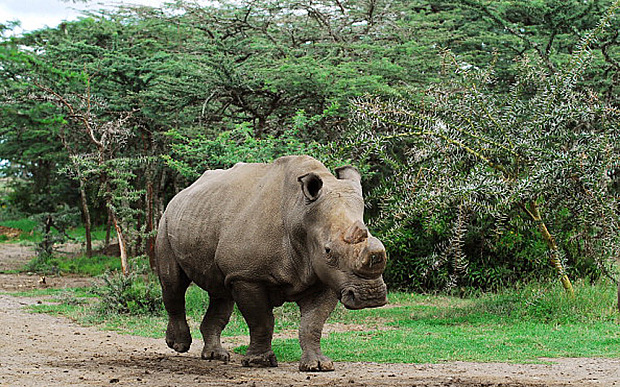One of Last Remaining Northern White Rhinos Dies in Kenya
ANIMAL RIGHTS - VEGETARIANISM, 27 Oct 2014
Harriet Alexander – The Telegraph
Only six northern white rhinos are left after Suni, a 34-year-old male, died in a conservancy in Kenya.
19 Oct 2014 – One of the last northern white rhinos has died in Kenya – leaving only six of the animals alive and edging the species closer to extinction.
The rhino, named Suni, was found dead on Friday by rangers at the Ol Pejeta Conservancy, 150 miles north of Nairobi. He was 34 years old, and thought to have died of natural causes – the conservancy said he was not killed by poachers.
Suni’s father Sunit also died at the age of 34, in 2006.
But as Suni was one of the last two breeding males in the world, the conservancy said that the species was likely to be completely wiped out.
“Consequently the species now stands at the brink of complete extinction, a sorry testament to the greed of the human race,” a spokesman said.
“We will continue to do what we can to work with the remaining three animals on Ol Pejeta in the hope that our efforts will one day result in the successful birth of a northern white rhino calf.”
Suni was born in the Dvur Kralove Zoo in the Czech Republic – the only place in the world where northern white rhinos have bred in captivity. Along with four others – Najin, Fatu and Sudan – Sunit was brought to Kenya in 2009 as part of a breeding programme to try and prevent the extinction of the species.
Wildlife experts had hoped the 90,000-acre private wildlife conservancy, framed on the equator and nestled between the snow capped Mount Kenya and the Aberdare mountain range, would offer a more favourable climate for breeding. As late as 1960, there were more than 2,000 northern white rhinos remaining – but widespread poaching decimated the population, and in 1984 only about 15 individuals survived in the wild – all in Garamba National Park in the Democratic Republic of Congo.
But they have struggled to sustain the population, and face a continuing threat from poachers.
Kenya has about 850 black and white rhinos out of approximately 25,000 in Africa. Last year, 59 rhinos were poached in the country.
Rhino horn sold on the streets of major Asian cities was last year more valuable than gold or platinum, with traders asking for about $65,000 per kg of rhino horn, which is used in herbal medicine.
A summit in London held earlier this year drew together world leaders from over 40 countries, who agreed to actions intended to eradicate the demand for wildlife products, strengthen law enforcement, and support the development of sustainable livelihoods for communities affected by wildlife crime.
The World Wildlife Fund said that ony four northern white rhinos now remain in the wild, in Garamba National Park in north-eastern DRC. The WWF said there were also unconfirmed reports of a few survivors in southern Sudan.
But while the northern white rhino faces extinction, the southern white rhino is the only non-endangered rhino, with an estimated 20,000 animals.
The majority of white rhinos occur in just four countries: South Africa, Namibia, Zimbabwe, and Kenya.
Go to Original – telegraph.co.uk
DISCLAIMER: The statements, views and opinions expressed in pieces republished here are solely those of the authors and do not necessarily represent those of TMS. In accordance with title 17 U.S.C. section 107, this material is distributed without profit to those who have expressed a prior interest in receiving the included information for research and educational purposes. TMS has no affiliation whatsoever with the originator of this article nor is TMS endorsed or sponsored by the originator. “GO TO ORIGINAL” links are provided as a convenience to our readers and allow for verification of authenticity. However, as originating pages are often updated by their originating host sites, the versions posted may not match the versions our readers view when clicking the “GO TO ORIGINAL” links. This site contains copyrighted material the use of which has not always been specifically authorized by the copyright owner. We are making such material available in our efforts to advance understanding of environmental, political, human rights, economic, democracy, scientific, and social justice issues, etc. We believe this constitutes a ‘fair use’ of any such copyrighted material as provided for in section 107 of the US Copyright Law. In accordance with Title 17 U.S.C. Section 107, the material on this site is distributed without profit to those who have expressed a prior interest in receiving the included information for research and educational purposes. For more information go to: http://www.law.cornell.edu/uscode/17/107.shtml. If you wish to use copyrighted material from this site for purposes of your own that go beyond ‘fair use’, you must obtain permission from the copyright owner.
Read more
Click here to go to the current weekly digest or pick another article:
ANIMAL RIGHTS - VEGETARIANISM:
